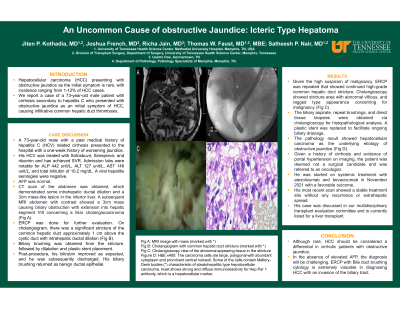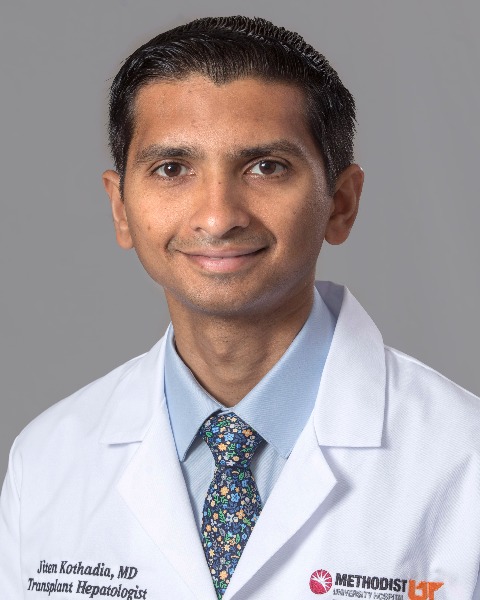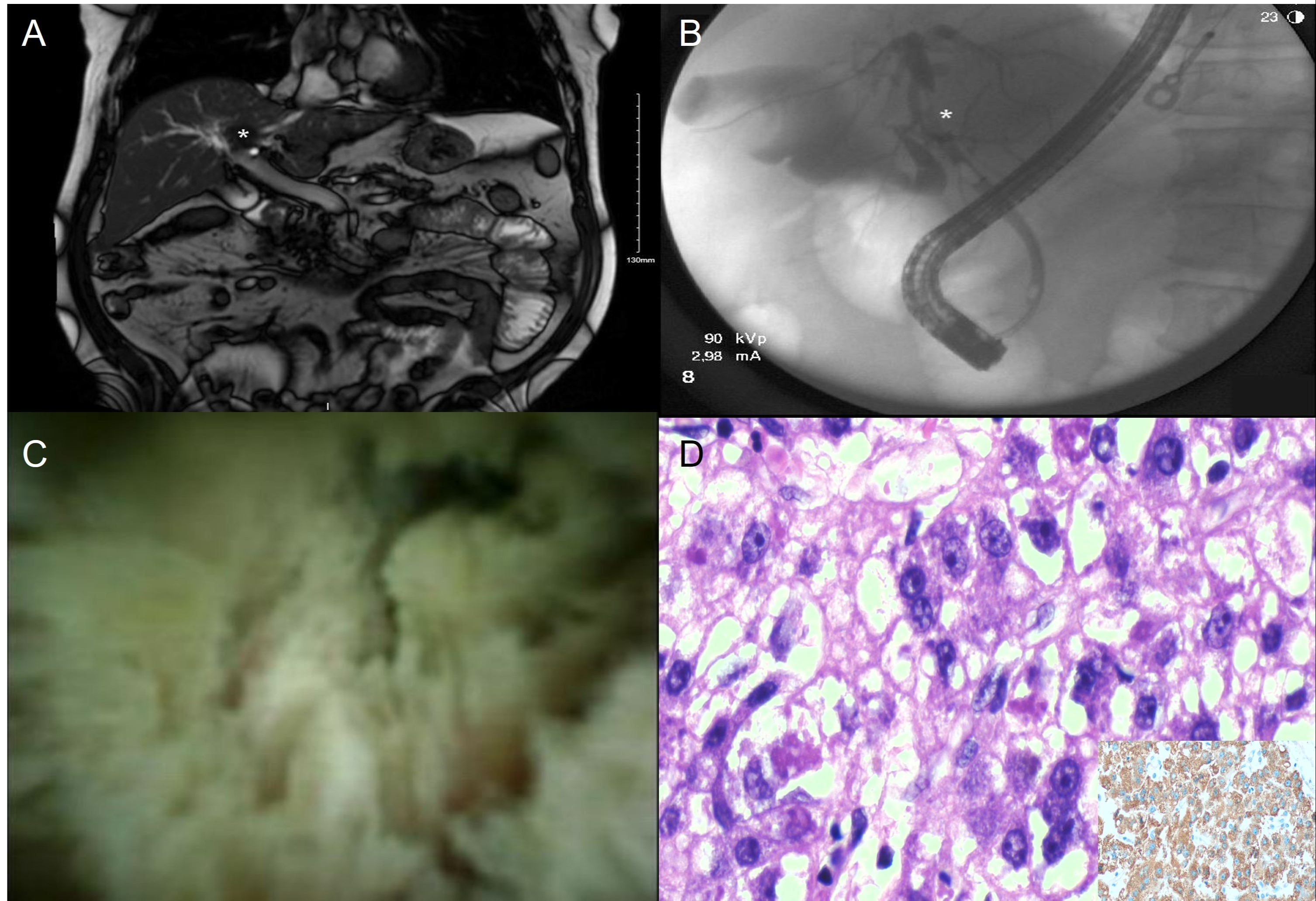Back


Poster Session A - Sunday Afternoon
Category: Liver
A0513 - An Uncommon Cause of Obstructive Jaundice: Icteric Type Hepatoma
Sunday, October 23, 2022
5:00 PM – 7:00 PM ET
Location: Crown Ballroom

Has Audio

Jiten P. Kothadia, MD
James D. Eason Transplant Institute, Methodist University Hospital, University of Tennessee Health Science Center
Memphis, TN
Presenting Author(s)
Jiten P. Kothadia, MD1, Joshua French, MD2, Richa Jain, MD3, Thomas W. Faust, MD, MBE4, Satheesh P. Nair, MD, FACG4
1James D. Eason Transplant Institute, Methodist University Hospital, University of Tennessee Health Science Center, Memphis, TN; 2Gastro One, Germantown, TN; 3Methodist University Hospital, Memphis, TN; 4James D. Eason Transplant Institute, Methodist University, University of Tennessee Health Science Center, Memphis, TN
Introduction: Hepatocellular carcinoma (HCC) presenting with obstructive jaundice as the initial symptom is rare, with incidence ranging from 1-12% of HCC cases. We report a case of a 73-year-old male patient with cirrhosis secondary to hepatitis C who presented with obstructive jaundice as an initial symptom of HCC.
Case Description/Methods: A 73-year-old male with history of hepatitis C (HCV) related cirrhosis presented to the hospital with a one-week history jaundice. Admission labs were notable for ALP 442 unit/L, ALT 127 unit/L, AST 146 unit/L, and total bilirubin of 10.2 mg/dL (0.2–1). A viral hepatitis serologies were negative. AFP was normal. CT scan of the abdomen showed some intrahepatic ductal dilation and a 3cm mass-like lesion in the inferior liver. A subsequent MRI abdomen with contrast showed a 3cm mass causing biliary obstruction with extension into hepatic segment VIII concerning a hilar cholangiocarcinoma (Fig 1A). Gastroenterology was consulted, and an ERCP was done. On cholangiogram, there was a significant stricture of the common hepatic duct approximately 1 cm above the cystic duct with intrahepatic ductal dilation (Fig B). Biliary brushing was obtained from the stricture, followed by plastic stent placement. Post-procedure, his bilirubin improved as expected. His biliary brushing returned as benign ductal epithelial.
Given the high suspicion of malignancy, ERCP was repeated. On cholangioscopy was performed, demonstrating the stricture area with concerning features for malignancy, including an abnormal, villious, and ragged type appearance. (Fig C and D). The biliary aspirate, repeat brushings, and direct tissue biopsies were obtained via cholangioscopy for histopathological analysis and plastic stent was replaced. The final pathology result showed hepatocellular carcinoma (Figure E). Given a history of cirrhosis and evidence of portal hypertension on imaging, the patient was deemed not a surgical candidate. He was started on treatment with atezolizumab and bevacizumab in November 2021 with a favorable outcome. His most recent scan showed a stable treatment site without any recurrence of extrahepatic spread. His case was discussed in our multidisciplinary transplant evaluation committee and he is considered for a liver transplant.
Discussion: Although rare, HCC should be considered a differential in cirrhotic patients presenting with obstructive jaundice. ERCP with Bile duct brushing cytology is extremely valuable in diagnosing HCC with an invasion of the biliary tract.

Disclosures:
Jiten P. Kothadia, MD1, Joshua French, MD2, Richa Jain, MD3, Thomas W. Faust, MD, MBE4, Satheesh P. Nair, MD, FACG4. A0513 - An Uncommon Cause of Obstructive Jaundice: Icteric Type Hepatoma, ACG 2022 Annual Scientific Meeting Abstracts. Charlotte, NC: American College of Gastroenterology.
1James D. Eason Transplant Institute, Methodist University Hospital, University of Tennessee Health Science Center, Memphis, TN; 2Gastro One, Germantown, TN; 3Methodist University Hospital, Memphis, TN; 4James D. Eason Transplant Institute, Methodist University, University of Tennessee Health Science Center, Memphis, TN
Introduction: Hepatocellular carcinoma (HCC) presenting with obstructive jaundice as the initial symptom is rare, with incidence ranging from 1-12% of HCC cases. We report a case of a 73-year-old male patient with cirrhosis secondary to hepatitis C who presented with obstructive jaundice as an initial symptom of HCC.
Case Description/Methods: A 73-year-old male with history of hepatitis C (HCV) related cirrhosis presented to the hospital with a one-week history jaundice. Admission labs were notable for ALP 442 unit/L, ALT 127 unit/L, AST 146 unit/L, and total bilirubin of 10.2 mg/dL (0.2–1). A viral hepatitis serologies were negative. AFP was normal. CT scan of the abdomen showed some intrahepatic ductal dilation and a 3cm mass-like lesion in the inferior liver. A subsequent MRI abdomen with contrast showed a 3cm mass causing biliary obstruction with extension into hepatic segment VIII concerning a hilar cholangiocarcinoma (Fig 1A). Gastroenterology was consulted, and an ERCP was done. On cholangiogram, there was a significant stricture of the common hepatic duct approximately 1 cm above the cystic duct with intrahepatic ductal dilation (Fig B). Biliary brushing was obtained from the stricture, followed by plastic stent placement. Post-procedure, his bilirubin improved as expected. His biliary brushing returned as benign ductal epithelial.
Given the high suspicion of malignancy, ERCP was repeated. On cholangioscopy was performed, demonstrating the stricture area with concerning features for malignancy, including an abnormal, villious, and ragged type appearance. (Fig C and D). The biliary aspirate, repeat brushings, and direct tissue biopsies were obtained via cholangioscopy for histopathological analysis and plastic stent was replaced. The final pathology result showed hepatocellular carcinoma (Figure E). Given a history of cirrhosis and evidence of portal hypertension on imaging, the patient was deemed not a surgical candidate. He was started on treatment with atezolizumab and bevacizumab in November 2021 with a favorable outcome. His most recent scan showed a stable treatment site without any recurrence of extrahepatic spread. His case was discussed in our multidisciplinary transplant evaluation committee and he is considered for a liver transplant.
Discussion: Although rare, HCC should be considered a differential in cirrhotic patients presenting with obstructive jaundice. ERCP with Bile duct brushing cytology is extremely valuable in diagnosing HCC with an invasion of the biliary tract.

Figure: Fig A: MRI image with mass (marked with *)
Fig B: Cholangiogram with common hepatic duct stricture (marked with *)
Fig C: Cholangioscopy view of the abnormal appearing tissue in the stricture
Figure D: H&E x400: The carcinoma cells are large, polygonal with abundant cytoplasm and prominent central nulceoli. Some of the cells contain Mallory-Denk bodies (*) characteristic of steatohepatitic type hepatocellular carcinoma. Inset shows strong and diffuse immunoreactivity for Hep Par 1 antibody, which is a hepatocellular marker.
Fig B: Cholangiogram with common hepatic duct stricture (marked with *)
Fig C: Cholangioscopy view of the abnormal appearing tissue in the stricture
Figure D: H&E x400: The carcinoma cells are large, polygonal with abundant cytoplasm and prominent central nulceoli. Some of the cells contain Mallory-Denk bodies (*) characteristic of steatohepatitic type hepatocellular carcinoma. Inset shows strong and diffuse immunoreactivity for Hep Par 1 antibody, which is a hepatocellular marker.
Disclosures:
Jiten Kothadia indicated no relevant financial relationships.
Joshua French indicated no relevant financial relationships.
Richa Jain indicated no relevant financial relationships.
Thomas Faust indicated no relevant financial relationships.
Satheesh Nair indicated no relevant financial relationships.
Jiten P. Kothadia, MD1, Joshua French, MD2, Richa Jain, MD3, Thomas W. Faust, MD, MBE4, Satheesh P. Nair, MD, FACG4. A0513 - An Uncommon Cause of Obstructive Jaundice: Icteric Type Hepatoma, ACG 2022 Annual Scientific Meeting Abstracts. Charlotte, NC: American College of Gastroenterology.
